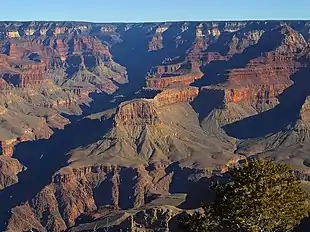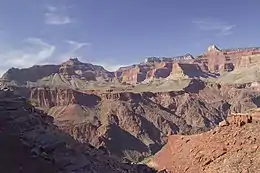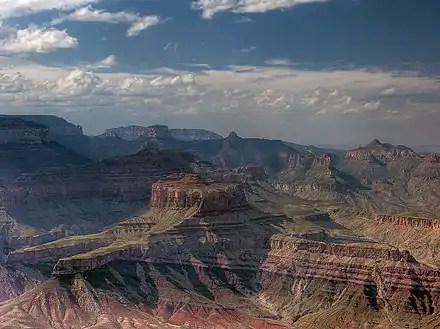Tapeats Sandstone
The Cambrian Tapeats Sandstone is the lower geologic unit, about 230 feet (70 m) thick,[4] at its maximum, of the 3-member Tonto Group. It is famous for being the highly-resistant mostly-horizontal unit above the 1,000 my (1 by), Great Unconformity expressed areally in the Grand Canyon of Arizona; also in other areas of Arizona and adjacent Nevada.
| Tapeats Sandstone Stratigraphic range: Early to Middle Cambrian[1][2] | |
|---|---|
 Muav Limestone-(greenish, slope-forming) and Bright Angel Shale, resting on Tapeats and the Tonto Platform, inner canyon, Granite Gorge (the two units are easily seen below the red-stained Redwall Limestone) (550 ft thick) | |
| Type | Geological formation |
| Unit of | Tonto Group |
| Underlies | Bright Angel Shale |
| Overlies | Vishnu Basement Rocks, Unkar Group, Nankoweap Formation, Chuar Group, and Sixtymile Formation |
| Thickness | 230 feet (70 m) |
| Lithology | |
| Primary | sandstone and conglomerate |
| Other | conglomeratic sandstone |
| Location | |
| Region | northern Arizona (Grand Canyon), central Arizona, southeast California, southern Nevada, and southeast Utah |
| Country | United States of America |
| Type section | |
| Named for | Tapeats Creek[3] |
| Named by | Noble (1914)[3] |
The Tapeats Sandstone is the highly erosion-resistant unit laid upon the Vishnu Basement Rocks in the central, parts of east, and parts of west Grand Canyon, Arizona. The unit comprises the 'base horizontal unit' of the platform around Granite Gorge (Inner Gorge) on the Colorado River, and because of its hardness, creates the Tonto Platform upon which the slope-forming, Bright Angel Shale, (extensive, and distinctively soft drab-greenish), and above it low cliff-forming cliff of Muav Limestone lie.
The Tapeats Sandstone and the Tonto Platform follow the Colorado River, and surrounding tributary canyons, creeks, watercourses, or washes, in a dendritic fashion, much like the branches of a tree.
The Tapeats unit is the bottom member of the Tonto Group, a typical marine transgression series of sandstone-(conglomerate)-shale-limestone, all part of a paleo sea, initially adjacent to land, the source of the Tapeats rocks-(conglomerates) and sand; (a regressing sequence has the reverse order). The Tapeats Sea at the early Devonian ceased to deposit more Muav Limestone, and a period of erosion ensued, a deposition unconformity.
The Tapeats Sandstone was laid upon the Vishnu Basement Rocks, after an unconformity of erosion, the Great Unconformity, of 1,000 million years (1.0 billion). Besides the erosion unconformity, the Unkar Group of the basement rocks are also at an angular unconformity, being an 8-member sequence tilted at 45 degrees.
The horizontal Tonto Platform has hiking trails that cross it from the South Rim to North Rim, Grand Canyon for instance. The extensive Tonto Trail lies on parts of the Tapeats Sandstone, and the platform on the south side of Granite Gorge.
Geologic sequence
The units of the Tonto Group:
- 3--Muav Limestone
- 2--Bright Angel Shale
- 1--Tapeats Sandstone (start of transgression series)
Gallery Tapeats Sandstone
Examples of the deposition unconformity of time (550-800 million yrs), the Great Unconformity. The Tapeats approximately 200 ft thick.
.jpg.webp) Tapeats Sandstone on the Great Unconformity on Vishnu Schist, covered by erosional layers masking the schist.
Tapeats Sandstone on the Great Unconformity on Vishnu Schist, covered by erosional layers masking the schist. View of Tonto Group, in descending order: Muav Limestone, Bright Angel Shale, and Tapeats Sandstone, overlying the Great Unconformity cut into Vishnu Basement Rocks in Granite Gorge region.
View of Tonto Group, in descending order: Muav Limestone, Bright Angel Shale, and Tapeats Sandstone, overlying the Great Unconformity cut into Vishnu Basement Rocks in Granite Gorge region. Another view of Tonto Group, in descending order: Muav Limestone, Bright Angel Shale, and Tapeats Sandstone, overlying the Great Unconformity cut into Vishnu Basement Rocks in Granite Gorge region.
Another view of Tonto Group, in descending order: Muav Limestone, Bright Angel Shale, and Tapeats Sandstone, overlying the Great Unconformity cut into Vishnu Basement Rocks in Granite Gorge region. view opposite Lipan Point, (at Desert View (Grand Canyon), East Rim), showing the banded Nankoweap Formation, (horizontal Tapeats at left, extending at base of prominence, in two fingers of rock)
view opposite Lipan Point, (at Desert View (Grand Canyon), East Rim), showing the banded Nankoweap Formation, (horizontal Tapeats at left, extending at base of prominence, in two fingers of rock) Tapeats Sandstone ledges in Salt Creek, Grand Canyon National Park
Tapeats Sandstone ledges in Salt Creek, Grand Canyon National Park
See also
| Wikimedia Commons has media related to Tapeats Sandstone. |
References
- Rose, E (2006) "Nonmarine aspects of the Cambrian Tonto Group of the Grand Canyon, USA, and broader implications." Palaeoworld. 15:223–241.
- Rose, E (2011) Modification of the nomenclature and a revised deposition model for the Cambrian Tonto Group of the Grand Canyon, Arizona. in JS Hollingsworth, FA Sundberg, and JR Foster, eds., pp 77-98, Cambrian Stratigraphy and Paleontology of Northern Arizona and Southern Nevada: Museum of Northern Arizona Bulletin 67, 321 p.
- Noble, LF (1914) The Shinumo quadrangle, Grand Canyon district, Arizona. Bulletin no. 549, US Geological Survey, Reston, Virginia.
- Chronic, H (1983) Roadside Geology of Arizona. The Mountaineers Books, Seattle, Washington. (softcover, ISBN 978-0-87842-147-3) p. 179.
Popular Publications
- Blakey, Ron and Wayne Ranney, Ancient Landscapes of the Colorado Plateau, Grand Canyon Association (publisher), 2008, 176 pages, ISBN 978-1934656037
- Chronic, Halka. Roadside Geology of Arizona, Mountain Press Publishing Co., 1983, 23rd printing, pp. 229–232, ISBN 978-0-87842-147-3
- Lucchitta, Ivo, Hiking Arizona's Geology, 2001, Mountaineers's Books, ISBN 0-89886-730-4
External links
| Wikimedia Commons has media related to Tapeats Sandstone. |
- Anonymous (2011a) Tonto Group, Stratigraphy of the Parks of the Colorado Plateau. U.S. Geological Survey, Reston, Virginia.
- Anonymous (2011b) Tapeats Sandstone, Stratigraphy of the Parks of the Colorado Plateau. U.S. Geological Survey, Reston, Virginia.
- Anonymous (2011c) Bright Angel Shale, Stratigraphy of the Parks of the Colorado Plateau. U.S. Geological Survey, Reston, Virginia.
- Anonymous (2011c) Muav Limestone, Stratigraphy of the Parks of the Colorado Plateau. U.S. Geological Survey, Reston, Virginia.
- Brandriss, M. (2004) Angular unconformity between Proterozoic and Cambrian rocks, Grand Canyon, Arizona. GeoDIL, A Geoscience Digital Image Library, University of North Dakota, Grand Forks, North Dakota.
- Mathis, A., and C. Bowman (2007) The Grand Age of Rocks: The Numeric Ages for Rocks Exposed within Grand Canyon, Grand Canyon National Park, Arizona., National Park Service, Grand Canyon National Park, Arizona.
- Rowland, S. (nda) Frenchman Mountain Great Unconformity site. Department of Geoscience, University of Nevada, Las Vegas, Nevada.
- Rowland, S. (ndb) Geologic Map of Frenchman Mountain. Department of Geoscience, University of Nevada, Las Vegas, Nevada.
- Rowland, S. (ndc) Frenchman Mountain and the Great Unconformity. Department of Geoscience, University of Nevada, Las Vegas, Nevada.
- Share, J. (2102a) The Great Unconformity of the Grand Canyon and the Late Proterozoic-Cambrian Time Interval: Part I - Defining It.
- Share, J. (2102a) The Great Unconformity and the Late Proterozoic-Cambrian Time Interval: Part II - The Rifting of Rodinia and the "Snowball Earth" Glaciations That Followed.
- Timmons, M. K. Karlstrom, and C. Dehler (1999) Grand Canyon Supergroup Six Unconformities Make One Great Unconformity A Record of Supercontinent Assembly and Disassembly. Boatman's Quarterly Review. vol. 12, no. 1, pp. 29–32.
- Timmons, S. S. (2003) Learning to Read the Pages of a Book (Grand Canyon Geology Training Manual), National Park Service, Grand Canyon National Park, Arizona.